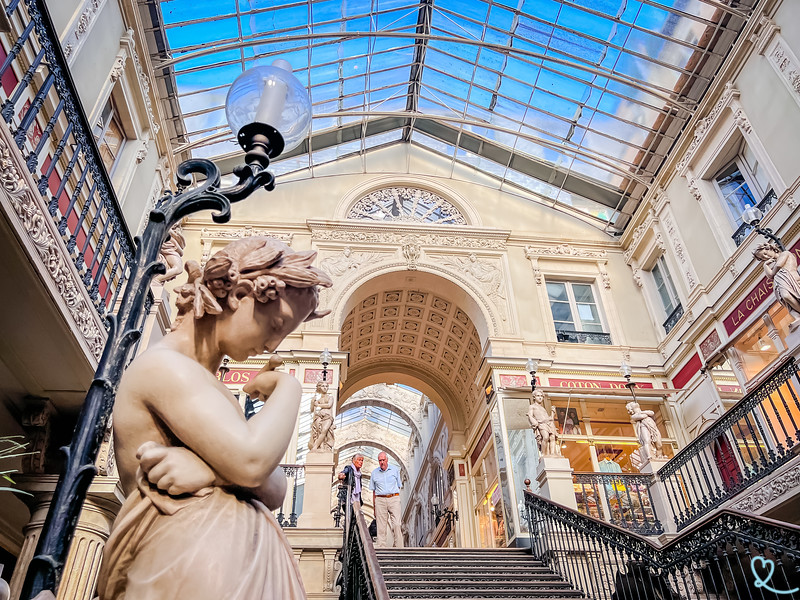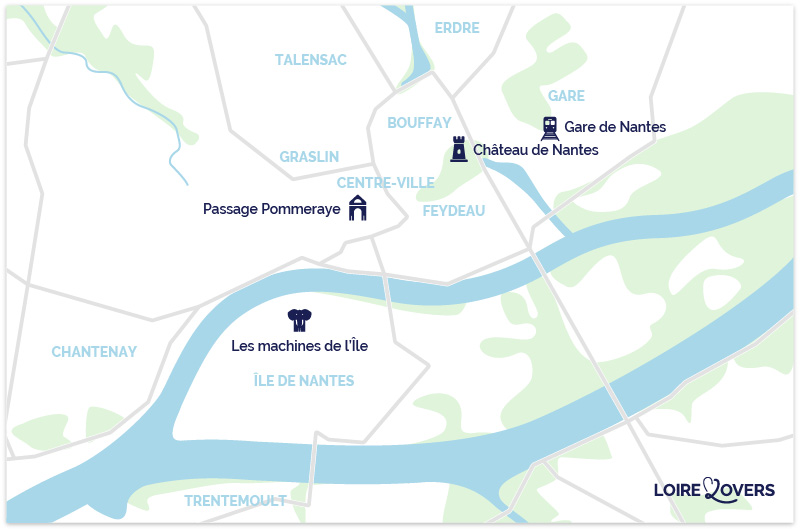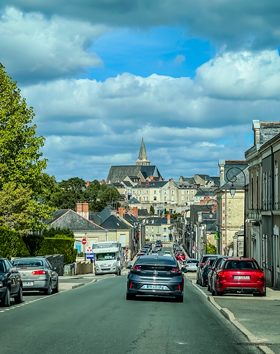The Passage Pommeraye is a rich shopping mall built in Nantes between 1840 and 1843. Right in the heart of the city, it offered elegant 19th-century women a place to socialize, to see and be seen.
In a city where the weather is not always constant, light is omnipresent with its impressive iron and glass windows and wrought iron fixtures.
Even if you don't plan to go shopping, take the time to stroll through the Passage Pommeraye and follow our practical advice and anecdotes to make sure you don't miss anything of this splendid gallery, unique in Europe.

This guide is completely independent, based on our experiences. We visited the region anonymously, making our own choices and paying our bills in full.
Why visit the Passage Pommeraye?
Is the Passage Pommeraye worth it? Our opinion:
The Passage Pommeraye is, in a way, the 19th-centuryequivalent of the Elephant . It splendidly embodies the evolution of Nantes, which grew considerably richer in the 18th and 19th centuries thanks to the development of maritime trade. Sugar refiners were the main backers of the original project.
The architecture is grandiose, mostly ofneoclassical inspiration, favoring the harmony of proportions, the great purified and sober lines. The rich decorations are more imaginative, borrowing from the eclecticism that was beginning to inspire architects in the mid-19th century.

But what we like best about this place is its timelessness. In just a few meters, you leave behind the urban world of Nantes and immerse yourself in thebourgeois world of 19th-century France. Every minute we expect to see an elegant woman with a hat and a puffy dress emerge from one of the signs.
Why is the Passage Pommeraye famous?
Numerous passages of this type appeared in France in the first half of the 19th century, notably in Paris near the Grands Boulevards.
What makes this passage unique in Europe is its sloping plan. You will indeed go down or up 9.40 meters, without really realizing it.

Around a monumental staircase, you will visit progressively 3 levels without any particular effort, nothing should disturb the trade!
WHERE TO STAY IN Nantes
Downtown
Would you like to sleep in the heart of Nantes and enjoy its invigorating vitality? We liked it:
- Blu Radisson Hotel - see our article - see photos prices and availability
- L'Oceania - hotel de France - see our article - see photos prices and availability

Near the station
A train to catch at dawn, there's a truly magical address just 2 steps from Nantes train station:
- Le Sozo Hotel - see our article - see photos, prices and availability

On the banks of the Erdre
Looking for a bit of peace and quiet, without straying too far from the city of Nantes? 2 addresses on the banks of the Erdre river:
- La Rivière House - see photos, prices and availability
- Le Best Western Plus Hôtel de la Régate - view photos, prices and availability

History in brief
The year is 1840. France lives under the reign of Louis-Philippe and the July Monarchy. After the troubles of the revolution and the revolutionary epics, it is a liberal and bourgeois turn which takes place in the French society.

The city of Nantes grew rich during the 18th century as Europe's leading port for the triangular trade. No less than 1427 shipments left the port of Nantes between 1715 and 1789 to exchange European goods for black slaves in Africa, which were then exchanged for colonial products in America (cocoa, coffee, sugar). The slave trade finally came to an end in the early 19th century, but the foundations of world trade had been laid and Nantes' wealth established.
Charles Guilloux, a restaurant owner on the rue de Santeuil, which runs alongside the future passage, joined forces with Louis Pommeraye to carry out a project to build a covered passageway designed by thearchitect Jean-Baptiste Buron.

Notary in Nantes from 1829 to 1836, Louis-Ange-Hyacinthe Pommeraye started his business in 1837 by buying the forest of Cellier, 30 km from Nantes. In 3 years, the 2 partners bought all the buildings concerned by the project.
Work began on July 31, 1840, under the direction of the Nantes architect Hippolyte Louis Théophile Durand-Gasselin, and was financed with the help of three large sugar refiners from Nantes. The city had 7 refineries and was the capital of sugar.
(I, Jibi44, Public domain, via Wikimedia Commons)
The Passage Pommeraye was opened to the public in June and officially inaugurated on July 3, 1843.
The economic crisis of 48 and the bad management of Louis Pommeraye, have reason of the company which exploits it, which is liquidated on February 16, 1849. Today, the passage, divided into lots, is owned by 76 co-owners (2017 figure).
In 2015, the Passage Pommeraye underwent an extension with the addition of a 3500m2 building connected to the1st floor.
Practical tips and map: the Passage Pommeraye in Nantes
The map

Where is the Passage Pommeraye?
- The passage of Nantes is located in the heart of downtown Nantes
- Driving time from Tours: 2h15
- Driving time from Angers: 1h15
- Driving time from Blois: 2h50
- Driving time from Orléans: 3h30
How to get there
To get to Nantes, you will be spoiled for choice, as the city has an international airport and a TGV station (18 return trips per day with Paris, for an average journey time of 2.5 hours).
- See all the lines that serve Nantes airport
- Book your private transportation from Nantes airport.
- See all trains now.

To get to the Passage Pommeraye, we advise you to take public transportation. The Passage Pommeraye is located in the heart of the city center in a pedestrian area. Wherever you live in Nantes you will have a bus or a tramway to drop you off a few hundred meters from the Passage Pommeraye. You can aim for the Commerce station, for example, where several lines intersect.
If you choose to drive, you can try to park within 200 meters of the passage, but traffic and parking are difficult in the heart of Nantes.
By opting for a city pass, you will have unlimited access to the city's well-developed public transport network and to 50 free services (museums, visits, cruises, etc.). We strongly recommend that you buy it in advance to avoid wasting time on site and waiting in line. See the conditions and book your City pass.
OUR TIPS FOR RENTING A CAR IN Loire
- Compare prices on our preferred platform: DiscoverCars - one of the best rated sites.
- Choose a fairly compact car (many villages have narrowed the road).
- Think aboutfull insurance (parking in big cities is really tight).
- There is a lot of demand, book it early.

Parking

To park, if you feel lucky you can try to park in the surrounding streets, but for more security, opt for the Graslin parking, the commercial parking or the mediatheque parking. In all cases, parking will be charged.
Best time to visit Passage Pommeraye
It is thecommercial activity that naturally generates the most traffic. If you want to visit quietly, we advise you to aim for the off-peak shopping hours, namely :
- Monday mornings: ideal to enjoy the architecture of the place, but many shops are closed.
- Early morning: before 10 a.m., you should be able to visit in peace and quiet, and store when they open at 10 a.m. at the latest.
- The first 15 days of August, the city of Nantes is empty but many businesses take advantage of this to close.
The worst period to visit the place is of course the beginning of the sales (January and end of June) and the month of December, even if theChristmas spirit takes over the Passage Pommeraye.
How long to visit the Passage Pommeraye and main difficulties
If you are not a shopaholic, a good half hour will be enough, the time to go through the passage in all directions and to feel the so particular atmosphere.
The floor is not difficult, but there are naturally steps that were designed by the architect to be gentle and accessible to all.
Advice on how to visit
You have to keep in mind that the plan of the passage is Y-shaped, with a low entrance (rue de la fosse), a secondary exit on the first level (rue du Puits d'Argent) and a main exit on thesecond level (rue Santeuil). The passage is divided into 4 galleries (Santeuil, Régnier, Horloge and Fosse) and extends over 134 meters.

We strongly advise you toenter by the top of the passage, by the rue Santeuil, and then to go down progressively to the exit rue de la fosse, making the small detour by the exit of the Puits d'Argent when you will be on the1st level.
We find indeed that, in addition to the beauty of the glass roof of the Galerie de Santeuil, the arrival on the Galerie de l'Horloge is more impressive while descending the steps.
Schedules
- Monday to Friday from 8am to 8pm.
- Saturday and Sunday from 9am to 8pm.
Check the latest prices/times on the official website
Guided tours
There is no guided tour of the Passage Pommeraye, but you can let yourself be tempted by a discovery of the city of Nantes with a private guide.
Restaurant
In the Passage Pommeraye, you can stop by the friendly tea room and small restaurant, La Passagère. We appreciate its wide choice of hot chocolates (no less than 6, including the surprising Choco Granny, a hot chocolate infused with "Visiting Granny" tea that reminds us of Sundays at our Scottish grandmother's house...) and its Sunday brunches!

A few steps from the Passage Pommeraye:
- If you want to stay in the bourgeois atmosphere of the passage, opt for the art nouveau decor of the famous brasserie La Cigale.
- If you want to continue your journey with the most beautiful flavors of the moment, let yourself be tempted by theexcellent restaurant imagined by the young chef Anne Lise GENOUËL.
- And you can come and pick up other good gastronomic addresses in our selection of the 15 best restaurants in Nantes!
A LITTLE MORE patience
All the photos, maps, information, good addresses to make your stay in the Loire Valley a success, will soon be gathered in a single ebook!
If you wish to be informed of the publication of our guide on the Loire, register:

Discovering the galleries of the Passage Pommeraye
We now take you on a discovery of the 4 galleries following the direction of visit we have just advised you. Let's go!
The gallery of Santeuil
It is located on the2nd level, in the extension of the entrance on rue de Santeuil. It offers shops on the first floor and residential units on the two upper levels, as well as a cellar along the entire length of the gallery.

We especially love the splendid glass roof, which is interspersed withstone arches with neobaroque decorations representing paradise plants and tangled vines.

This gallery seems to be directly inspired by the Vivienne gallery, built in 1823 in the2nd district of Paris.
The clock gallery (also called central gallery or gallery of statues)
Certainly, the most impressive gallery of the passage because of its strong declivity (9,40m), its monumental staircase, its large glass roof and its abundant decorations.

No less than 4 levels, 3 of which are dedicated to commerce, are linked by a series of pathways converging on the central staircase. 16 columns reinforce this impression of verticality.

The whole is magnificently illuminated by a large glass roof (10.20m) supported by fine metal arches.

The Régnier Gallery
The smallest in volume, it connects the entrance of the Silver Well to the central gallery.

It was added to the Passage in 1852 , after the company operating the Passage Pommeraye was bought out by its main creditor, Baron Henri Baillardel de Lareinty, who obtained the creation of a new opening onto Rue du Puits d'Argent.
Note that the Galerie de l'Horloge is sometimes referred to as the Galerie Régnier.
Subscribe to our Newsletter
- Get away from it all with Region Lovers' beautiful destinations!
- Once a month
- Advertising-free
The gallery of the pit
Located at the lowest level of the passage, in the extension of the entrance of the rue de la fosse, it is the longest of the 4 galleries (44,10m).

It offers shops on the first floor and apartments on the 2 upper floors along its entire length.

The most sober in terms of decoration, it impresses by its glass roof which is in one piece and almost self-supporting, supported by thin arches and different glass panels.
And the light was...
Having grown up in a commercial family, we can only testify to theimportance of the lighting atmosphere in the act of buying. After living in Nantes for a few years, we also know that the weather is sometimes (if not all the time) changeable. Add to that a depth of almost 10 meters to be lit and you see the challenge that the lighting of the Passage Pommeraye represented, when the electricity fairy had not yet appeared.

The canopies
We have already talked about it when we presented the different galleries, but the windows are the first source of light.

With the exception of the Santeuil gallery with its stone arches, they all rest on light structures to allow the diffusion of as much light as possible. This technical evolution was made possible by the advent of the industrial era, which opened the way to new innovations.
The mirrors
An old but still effective trick is the addition of mirrors on store signs in which natural and artificial light is multiplied.

Artificial lighting
From the moment it opened, the passageway was at the cutting edge of innovation, with agas lighting system cleverly concealed in the passageway's decorations.

At the beginning of the 20th century, the beautiful torchieres that masked the gas spouts were replaced by unattractive central electric chandeliers.
It was not until the major renovation campaign in 2015 that the original lights were returned to their original locations, but now equipped with LEDs. Only the lights above the windows, which date from 1930, will be retained and equipped with LEDs.
A setting with multiple influences
While the architecture is largely inspired by the sober lines of the neoclassical style, the architects have allowed themselves to be more imaginative in the decorations. Eclecticism was born during the construction of the Passage Pommeraye and advocates the use of the best of different styles or periods, assuming the mixing of genres. Its influence will continue until the 1920s in Europe.
The sculptures
Throughout the passage, you can revise your knowledge of art history, admiring the decorations neobarics between the floors of the Galerie de l'Horloge, the sculptures neo-newborns around the clock, or the coffered ceiling on the theme of nature between the gallery of Santeuil and those of the Clock. The capitals of the columns of the Clock Gallery could have been inspired by those of ancient Iran.

The statues
The statues in the Galerie de l'Horloge are the work of the Parisian sculptor Jean-Baptiste Joseph Debay, winner of the prestigious Prix de Rome in 1829.

Designed in terracotta, they are allegories of commerce, industry, agriculture, fine arts, entertainment and maritime trade.
The staircase
Its central position in the building, its monumentality, its ingenuity make it one of the key elements of the Passage Pommeraye.
In the name of safety, the staircase will have an iron structure but the steps and handrail will remain in oak.

The molded motifs in the cast iron, a 19th-century innovation, are the work of carpenter-modeller Lotz. The staircase was made by the gigantic Voruz foundries in Nantes, which employed up to 1600 people at their peak.
And the stores in all this
At the opening of the passage, 31 stores were in operation (some sites mention 66 businesses, but this seems impossible to us), food shops (including the restaurant of Charles Guilloux, co-founder of the passage with Louis Pommeraye), but also a hat shop, a jewelry store, 3 umbrella stores (indispensable in Nantes), a stationery store and a cutlery shop.
TheBrichet armory was the last original business to close at the beginning of the 20th century. No less than 4 generations will have succeeded one another in the store of the passage located in the gallery of the Fosse which counted up to 15 workmen who manufactured cartridges on the spot.
Today, the gallery has 33 stores with a great diversity (food, fashion, florist...) and a growing number of shops related to interior decoration, a sign of the times.
PLAN YOUR STAY IN Nantes
Itineraries

Visits






